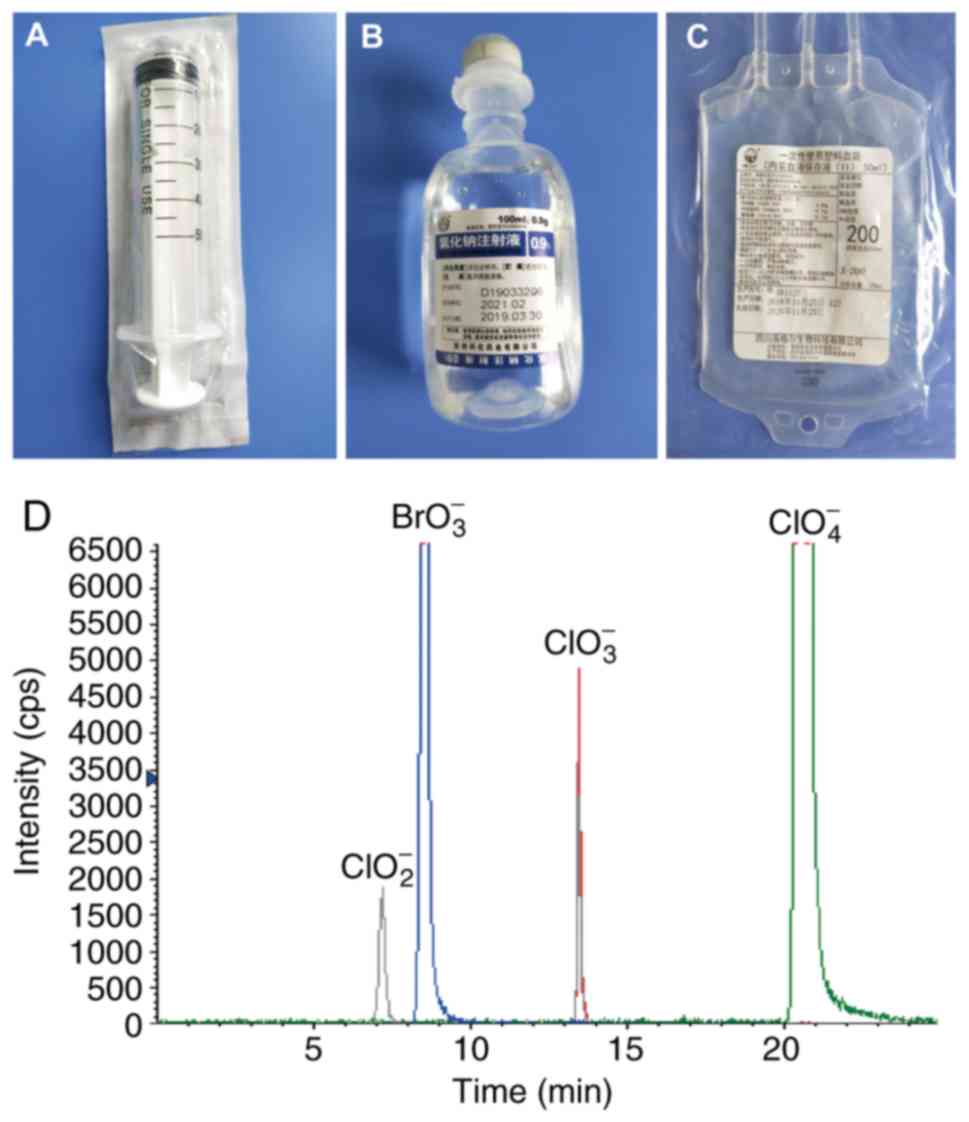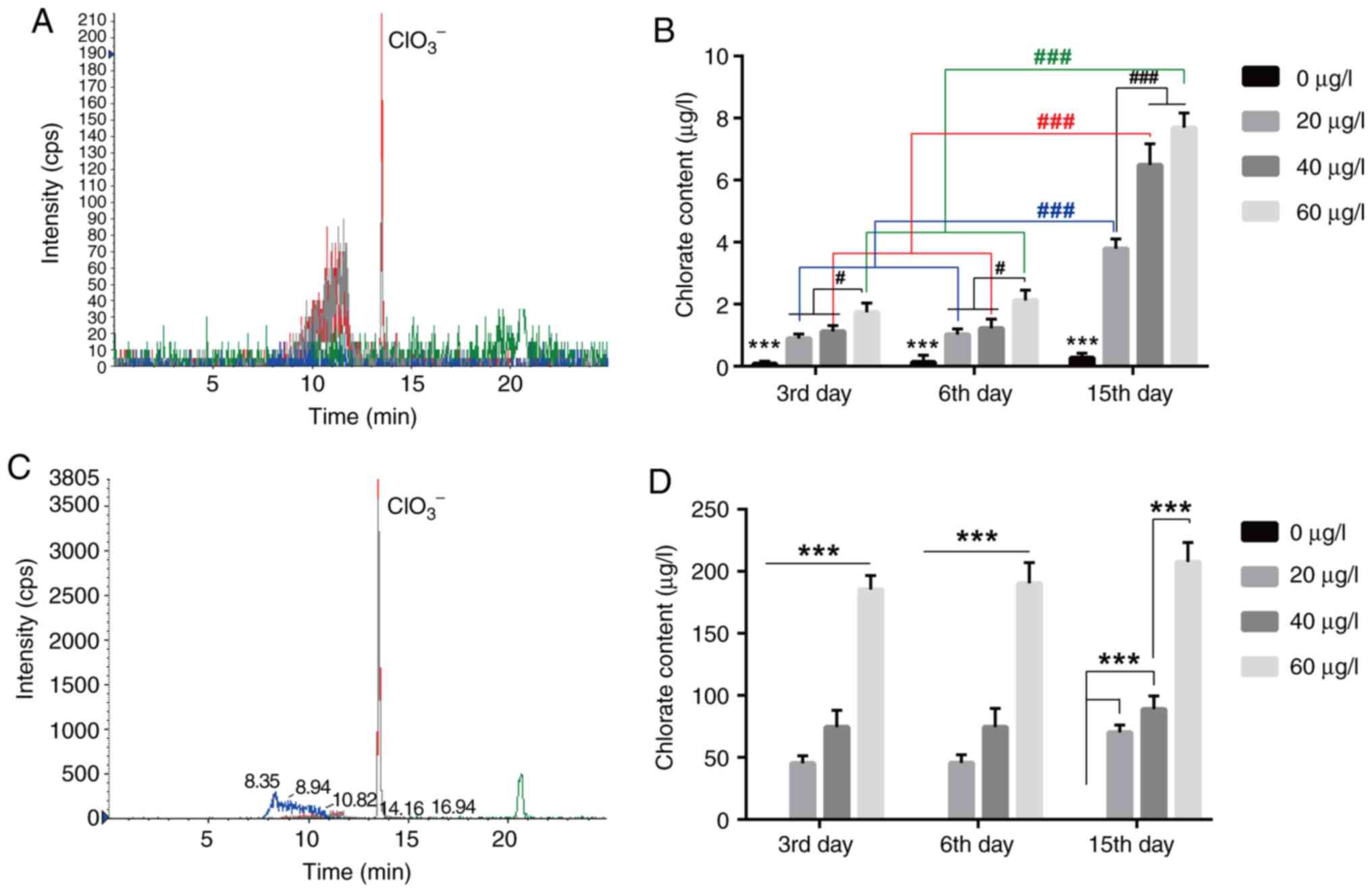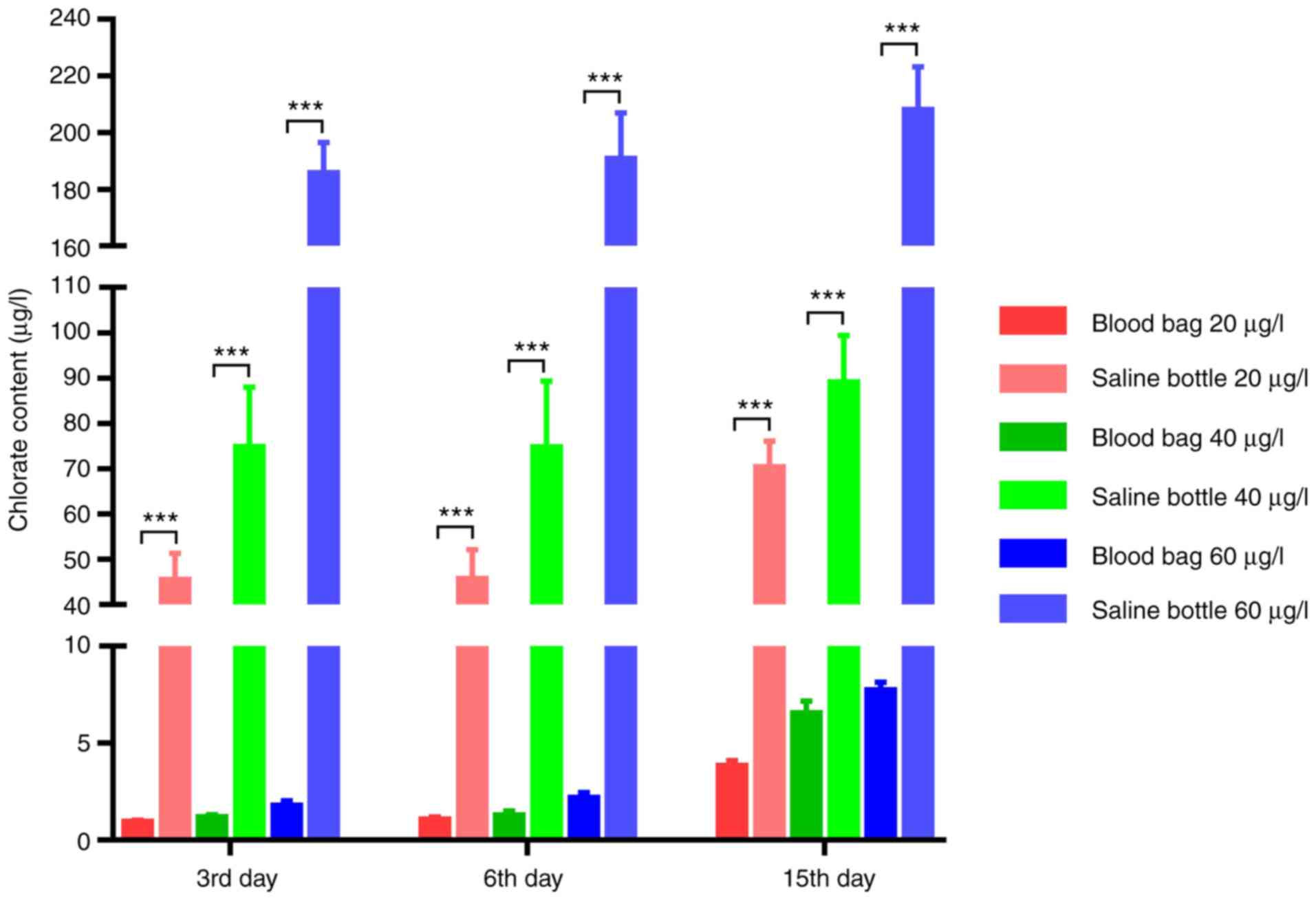|
1
|
Manoto SL, Maepa MJ and Motaung SK:
Medical ozone therapy as a potential treatment modality for
regeneration of damaged articular cartilage in osteoarthritis.
Saudi J Biol Sci. 25:672–679. 2018.PubMed/NCBI View Article : Google Scholar
|
|
2
|
Baranova IV: The use of the functional
state of the joints for the estimation of the effectiveness of the
application of oxygen/ozone therapy for the rehabilitative
treatment of the patients suffering from knee arthritis. Vopr
Kurortol Fizioter Lech Fiz Kult. 95:42–48. 2018.PubMed/NCBI View Article : Google Scholar : (In Russian).
|
|
3
|
Lopes de Jesus CC, Dos Santos FC, de Jesus
LMOB, Monteiro I, Sant'Ana M and Trevisani VFM: Comparison between
intra-articular ozone and placebo in the treatment of knee
osteoarthritis: A randomized, double-blinded, placebo-controlled
study. PLoS One. 12(e0179185)2017.PubMed/NCBI View Article : Google Scholar
|
|
4
|
Raeissadat SA, Tabibian E, Rayegani SM,
Rahimi-Dehgolan S and Babaei-Ghazani A: An investigation into the
efficacy of intra-articular ozone (O2-O3) injection in patients
with knee osteoarthritis: A systematic review and meta-analy. J
Pain Res. 11:2537–2550. 2018.PubMed/NCBI View Article : Google Scholar
|
|
5
|
Beyaz SG and Sayhan H: Six-month results
of cervical intradiscal oxygen-ozone mixture therapy on patients
with neck pain: Preliminary findings. Pain physician. 21:E449–E456.
2018.PubMed/NCBI
|
|
6
|
Elawamy A, Kamel EZ, Hassanien M, Wahba OM
and Amin SE: Implication of two different doses of intradiscal
ozone-oxygen injection upon the pain alleviation in patients with
low back pain: A randomized, single-blind study. Pain Physician.
21:E25–E31. 2018.PubMed/NCBI
|
|
7
|
Biazzo A, Corriero AS and Confalonieri N:
Intramuscular oxygen-ozone therapy in the treatment of low back
pain. Acta Biomed. 89:41–46. 2018.PubMed/NCBI View Article : Google Scholar
|
|
8
|
Costa T, Linhares D, Ribeiro da Silva M
and Neves N: Ozone therapy for low back pain. A systematic review.
Acta Reumatol Port. 43:172–181. 2018.PubMed/NCBI
|
|
9
|
Braidy N, Izadi M, Sureda A,
Jonaidi-Jafari N, Banki A, Nabavi SF and Nabavi SM: Therapeutic
relevance of ozone therapy in degenerative diseases: Focus on
diabetes and spinal pain. J Cell Physiol. 233:2705–2714.
2018.PubMed/NCBI View Article : Google Scholar
|
|
10
|
Raeissadat SA, Rayegani SM, Sadeghi F and
Rahimi-Dehgolan S: Comparison of ozone and lidocaine injection
efficacy vs dry needling in myofascial pain syndrome patients. J
Pain Res. 11:1273–1279. 2018.PubMed/NCBI View Article : Google Scholar
|
|
11
|
Tirelli U, Cirrito C, Pavanello M,
Piasentin C, Lleshi A and Taibi R: Ozone therapy in 65 patients
with fibromyalgia: An effective therapy. Eur Rev Med Pharmacol Sci.
23:1786–1788. 2019.PubMed/NCBI View Article : Google Scholar
|
|
12
|
Rowen RJ and Robins H: Ozone therapy for
complex regional pain syndrome: Review and case report. Curr Pain
Headache Rep. 23(41)2019.PubMed/NCBI View Article : Google Scholar
|
|
13
|
Lin SY, Zhang SZ, An JX, Qian XY, Gao XY,
Wang Y, Zhao WX, Eastwood D, Cope DK and Williams JP: The effect of
ultrasound-guided percutaneous ozone injection around cervical
dorsal root ganglion in zoster-associated pain: A retrospective
study. J Pain Res. 11:2179–2188. 2018.PubMed/NCBI View Article : Google Scholar
|
|
14
|
Hu B, Zheng J, Liu Q, Yang Y and Zhang Y:
The effect and safety of ozone autohemotherapy combined with
pharmacological therapy in postherpetic neuralgia. J Pain Res.
11:1637–1643. 2018.PubMed/NCBI View Article : Google Scholar
|
|
15
|
Di Mauro R, Cantarella G, Bernardini R, Di
Rosa M, Barbagallo I, Distefano A, Longhitano L, Vicario N,
Nicolosi D, Lazzarino G, et al: The Biochemical and pharmacological
properties of ozone: The smell of protection in acute and chronic
diseases. Int J Mol Sci. 20(pii: E634)2019.PubMed/NCBI View Article : Google Scholar
|
|
16
|
Clavo B, Santana-Rodriguez N, Gutierrez D,
Lopez JC, Suarez G, Lopez L, Robaina F and Bocci V: Long-term
improvement in refractory headache following ozone therapy. J
Altern Complement Med. 19:453–458. 2013.PubMed/NCBI View Article : Google Scholar
|
|
17
|
Li LY and Ni JX: Efficacy and safety of
ozonated autohemotherapy in patients with hyperuricemia and gout: A
phase I pilot study. Exp Ther Med. 8:1423–1427. 2014.PubMed/NCBI View Article : Google Scholar
|
|
18
|
Akbudak IH, Kucukatay V, Kilic-Erkek O,
Ozdemir Y and Bor-Kucukatay M: Investigation of the effects of
major ozone autohemotherapy application on erythrocyte
deformability and aggregation. Clin Hemorheol Microcirc.
71:365–372. 2019.PubMed/NCBI View Article : Google Scholar
|
|
19
|
Sancak EB, Turkön H, Çukur S, Erimsah S,
Akbas A, Gulpinar MT, Toman H, Sahin H and Uzun M: Major ozonated
autohemotherapy preconditioning ameliorates kidney
ischemia-reperfusion injury. Inflammation. 39:209–217.
2016.PubMed/NCBI View Article : Google Scholar
|
|
20
|
Bocci V: Ozonization of blood for the
therapy of viral diseases and immunodeficiencies A hypothesis. Med
Hypotheses. 39:30–34. 1992.PubMed/NCBI View Article : Google Scholar
|
|
21
|
Bocci V, Borrelli E, Travagli V and
Zanardi I: The ozone paradox: Ozone is a strong oxidant as well as
a medical drug. Med Res Rev. 29:646–682. 2009.PubMed/NCBI View Article : Google Scholar
|
|
22
|
Bocci V: Autohaemotherapy after treatment
of blood with ozone A reappraisal. J Int Med Res. 22:131–144.
1994.PubMed/NCBI View Article : Google Scholar
|
|
23
|
Tusat M, Mentese A, Demir S, Alver A and
Imamoglu M: Medical ozone therapy reduces oxidative stress and
testicular damage in an experimental model of testicular torsion in
rats. Int Braz J Urol. 43:1160–1166. 2017.PubMed/NCBI View Article : Google Scholar
|
|
24
|
Al-Saadi H, Potapova I, Rochford ET,
Moriarty TF and Messmer P: Ozonated saline shows activity against
planktonic and biofilm growing Staphylococcus aureus in vitro: A
potential irrigant for infected wounds. Int Wound J. 13:936–942.
2016.PubMed/NCBI View Article : Google Scholar
|
|
25
|
Sagai M and Bocci V: Mechanisms of action
involved in ozone therapy: Is healing induced via a mild oxidative
stress? Med Gas Res. 1(29)2011.PubMed/NCBI View Article : Google Scholar
|
|
26
|
Borrelli E: Mechanism of action of oxygen
ozone therapy in the treatment of disc herniation and low back
pain. Acta Neurochir Suppl. 108:123–125. 2011.PubMed/NCBI View Article : Google Scholar
|
|
27
|
Azuma K, Mori T, Kawamoto K, Kuroda K,
Tsuka T, Imagawa T, Osaki T, Itoh F, Minami S and Okamoto Y:
Anti-inflammatory effects of ozonated water in an experimental
mouse model. Biomed Rep. 2:671–674. 2014.PubMed/NCBI View Article : Google Scholar
|
|
28
|
Lu L, Pan C, Chen L, Hu L, Wang C, Han Y,
Yang Y, Cheng Z and Liu WT: AMPK activation by peri-sciatic nerve
administration of ozone attenuates CCI-induced neuropathic pain in
rats. J Mol Cell Biol. 9:132–143. 2017.PubMed/NCBI View Article : Google Scholar
|
|
29
|
Yu M, Zhao Y and Zhang X: Gardenoside
combined with ozone inhibits the expression of P2X3 and P2X7 purine
receptors in rats with sciatic nerve injury. Mol Med Rep.
17:7980–7986. 2018.PubMed/NCBI View Article : Google Scholar
|
|
30
|
Wang J, Wu M, Lin X, Li Y and Fu Z:
Low-concentration oxygen/ozone treatment attenuated radiculitis and
mechanical allodynia via PDE2A-cAMP/cGMP- NF-κB/p65 signaling in
chronic radiculitis rats. Pain Res Manag.
2018(5192814)2018.PubMed/NCBI View Article : Google Scholar
|
|
31
|
Wu MY, Xing CY, Wang JN, Li Y, Lin XW and
Fu ZJ: Therapeutic dosage of ozone inhibits autophagy and apoptosis
of nerve roots in a chemically induced radiculoneuritis rat model.
Eur Rev Med Pharmacol Sci. 22:1787–1797. 2018.PubMed/NCBI View Article : Google Scholar
|
|
32
|
Zhao X, Li Y, Lin X, Wang J, Zhao X, Xie
J, Sun T and Fu Z: Ozone induces autophagy in rat chondrocytes
stimulated with IL-1β through the AMPK/mTOR signaling pathway. J
Pain Res. 11:3003–3017. 2018.PubMed/NCBI View Article : Google Scholar
|
|
33
|
Fuccio C, Luongo C, Capodanno P, Giordano
C, Scafuro MA, Siniscalco D, Lettieri B, Rossi F, Maione S and
Berrino L: A single subcutaneous injection of ozone prevents
allodynia and decreases the over-expression of pro-inflammatory
caspases in the orbito-frontal cortex of neuropathic mice. Eur J
Pharmacol. 603:42–49. 2009.PubMed/NCBI View Article : Google Scholar
|
|
34
|
Karatieieva S, Muzyka N, Semenenko S,
Bakun O and Kozlovskaya I: Ultrastructural changes of wound
macrophages under the influence of intravenous ozone therapy in
patients with diabetes and inflammatory processes of soft tissues.
Georgian Med. News:98–101. 2018.PubMed/NCBI
|
|
35
|
Tafil-Klawe M, Woźniak A, Drewa T,
Ponikowska I, Drewa J, Drewa G, Włodarczyk K, Olszewska D, Klawe J
and Kozłowska R: Ozone therapy and the activity of selected
lysosomal enzymes in blood serum of patients with lower limb
ischaemia associated with obliterative atheromatosis. Med Sci
Monit. 8:CR520–CR525. 2002.PubMed/NCBI
|
|
36
|
Katiukhin LN: Influence of the course of
treatment by injections of ozonized saline on rheological
properties of erythrocytes in patients with complex pathology. Hum
Physiol. 42:672–677. 2016.PubMed/NCBI
|
|
37
|
Volkhovskaya NB, Tkachenko SB and
Belopolsky AA: Modulation of phagocytic activity of blood
polynuclear leukocytes with ozonized physiological saline. Bull Exp
Biol Med. 146:559–561. 2008.PubMed/NCBI View Article : Google Scholar
|
|
38
|
Qu DD, Peng FJ, Liu L, Yang SL and Guo YB:
Effect of ozonized saline on signaling passway of Keap1-Nrf2-ARE in
rat hepatocytes. Zhonghua Gan Zang Bing Za Zhi. 19:367–371.
2011.PubMed/NCBI View Article : Google Scholar : (In Chinese).
|
|
39
|
Razumovskii SD, Konstantinova ML,
Grinevich TV, Korovina GV and Zaitsev VY: Mechanism and kinetics of
the reaction of ozone with sodium chloride in aqueous solutions.
Kinet Catal. 51:492–496. 2010.
|
|
40
|
Boyarinov GA, Gordetsov AS, Peretyagin SP,
Boyarinova LV and Martusevich AK: Chemical transformations in
treatment of saline solution with ozone-oxygen gas mixture. J
Health Inequal. 2:194–199. 2016.
|
|
41
|
Bocci V, Zanardi I, Borrelli E and
Travagli V: Reliable and effective oxygen-ozone therapy at a
crossroads with ozonated saline infusion and ozone rectal
insufflation. J Pharm Pharmacol. 64:482–489. 2012.PubMed/NCBI View Article : Google Scholar
|
|
42
|
Zhang T, Cui H, Hu D, Cai F, Ma J and Zhu
Q: Simultaneous determination of chlorite, chlorate, perchlorate
and bromate of seafood processed products by IC-MS. Food Sci
Technol. 42:326–330. 2017.(In Chinese).
|
|
43
|
WHO. Guidelines Approved by the Guidelines
Review Committee. In: Guidelines for drinking-water quality: Fourth
edition incorporating the first addendum World Health Organization,
Geneva, 2017.
|
|
44
|
Smith DJ, Taylor JB, West M and Herges G:
Effect of intravenous or oral sodium chlorate administration on the
fecal shedding of Escherichia coli in sheep. J Anim Sci.
91:5962–5969. 2013.PubMed/NCBI View Article : Google Scholar
|
|
45
|
Ali SN, Ansari FA, Arif H and Mahmood R:
Sodium chlorate induces DNA damage and DNA-protein cross-linking in
rat intestine: A dose dependent study. Chemosphere. 177:311–316.
2017.PubMed/NCBI View Article : Google Scholar
|
|
46
|
Ali SN, Arif H, Khan AA and Mahmood R:
Acute renal toxicity of sodium chlorate: Redox imbalance, enhanced
DNA damage, metabolic alterations and inhibition of brush border
membrane enzymes in rats. Environ Toxicol. 33:1182–1194.
2018.PubMed/NCBI View Article : Google Scholar
|
|
47
|
Ali SN, Ahmad MK and Mahmood R: Sodium
chlorate, a herbicide and major water disinfectant byproduct,
generates reactive oxygen species and induces oxidative damage in
human erythrocytes. Environ Sci Pollut Res Int. 24:1898–1909.
2017.PubMed/NCBI View Article : Google Scholar
|
|
48
|
Khan MA, Fenton SE, Swank AE, Hester SD,
Williams A and Wolf DC: A mixture of ammonium perchlorate and
sodium chlorate enhances alterations of the pituitary-thyroid axis
caused by the individual chemicals in adult male F344 rats. Toxicol
Pathol. 33:776–783. 2005.PubMed/NCBI View Article : Google Scholar
|
|
49
|
National Toxicology Program: Toxicology
and carcinogenesis studies of sodium chlorate (Cas No. 7775-09-9)
in F344/N rats and B6C3F1 mice (drinking water studies). Natl
Toxicol Program Tech Rep Ser: 1-255, 2005.
|

















